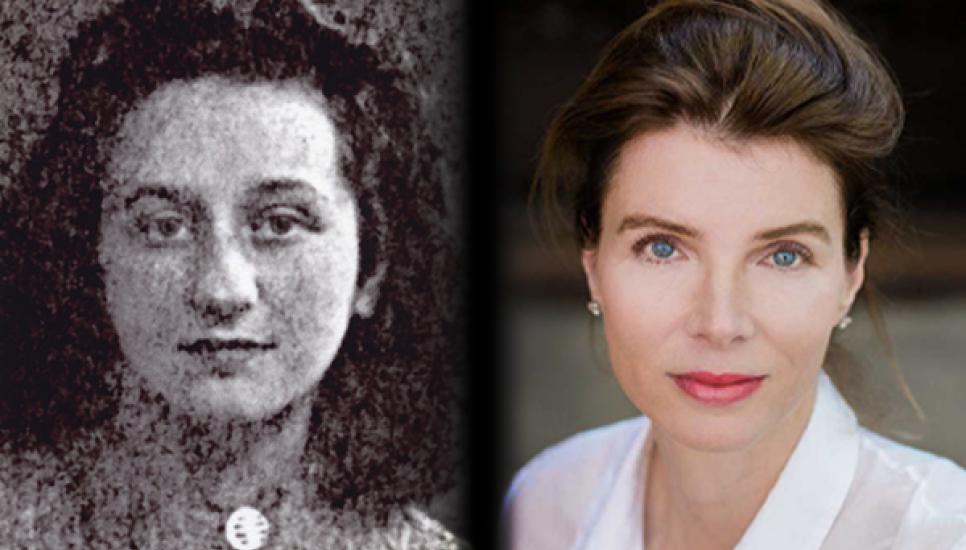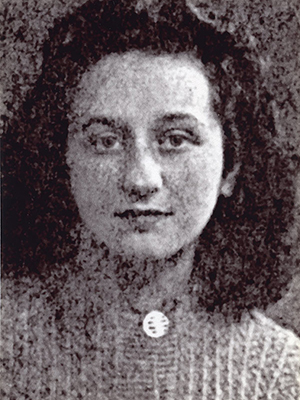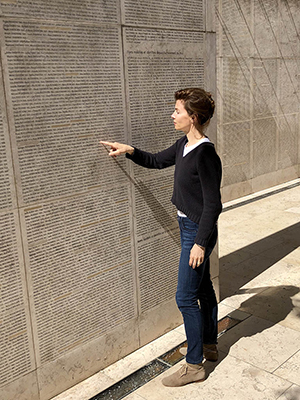Connecting family members through generations: How my husband's ancestor changed my life

“Life is like a box of chocolates, you never know what you're going to get” - Forrest Gump…
When I married my husband, Pascal Levensohn, in 2013 and took his last name, the wisdom of Forrest’s words really hit home. Even now, my rational mind still doesn’t fully comprehend the extraordinary coincidence that was forged though our union and changed my life forever. Or was it fate?
With my new name, Melanie Levensohn, I became the namesake of my husband’s cousin once removed. Pascal is Jewish, and his father was interned in a concentration camp in Romanian-controlled Transnistria (today part of Moldova) before he managed to escape and flee to Canada. But Pascal’s cousin once removed, Melanie Levensohn, was not as fortunate.
She lived in France as a young student in the early 1940s. In December 1943, at the tender age of 19, she was arrested by the French police, handed over to the Germans, and deported via the detention camp Drancy to Auschwitz. Nobody knows for sure if she survived the camp or not.
Pascal’s family never talked about the cousin in France who disappeared during the Second World War, just as most survivors couldn’t speak about the horrendous atrocities they endured during this darkest period of German history.

Pascal first learned of Melanie’s existence in 2005, at the bat-mitzvah celebration of his oldest daughter, Amanda, when his other cousin once removed, Jacobina Löwensohn, finally revealed the existence of her half-sister Melanie. Jacobina’s father Lica had told Jacobina about his first marriage, and daughter Melanie, for the first time on his death bed in 1984. At that sad and intense moment of his imminent passing, he asked Jacobina to search for Melanie. And a shocked Jacobina promised to do so.
She spent over ten years trying to find the half-sister she never knew. Her first destination was the United States Holocaust Memorial Museum in Washington D.C., which runs an extensive archive documenting victims and survivors. A researcher pointed her to Serge Klarsfeld’s Chronicle of Jews deported from France, where Melanie is mentioned as being deported on a train, together with 850 other Jews.
 Jacobina also wrote to the American Red Cross Holocaust Victims Tracing Center, the International Tracing Service in Bad Arolsen in Germany, as well as to the Shoah Memorial in Paris and many other organizations.
Jacobina also wrote to the American Red Cross Holocaust Victims Tracing Center, the International Tracing Service in Bad Arolsen in Germany, as well as to the Shoah Memorial in Paris and many other organizations.
The responses were emotionally disturbing. The Shoah Memorial sent a copy of Melanie’s entry card to Drancy and a photograph. In addition, Jacobina received several photocopies of faxes signed by high-ranking Gestapo officers confirming Melanie’s departure on Convoy 63 from Paris to Auschwitz on December 17, 1943. All traces ended there, suggesting she was murdered.
One researcher, however, came to a different conclusion. George Dreyfus, who in the 1980s compiled a list of Holocaust victims similar to Klarsfeld’s, mentions Melanie Levensohn as a “rescapée”, a survivor, igniting a glimpse of hope in Jacobina. Unfortunately, there was no further indication of where Melanie could have gone after being freed. And soon afterwards, the American Red Cross in Baltimore sent Jacobina the distressing truth, that Melanie did not survive the camp.
Jacobina kept the letters and historical documents in a binder and, after accepting her half-sister’s death at Auschwitz, gave it to Pascal.
I cannot think of a more powerful and healing connection between past and present family members than Melanie’s and mine.
Years later I found the binder in his office and immersed myself in Melanie’s tragic life. Reading my name on those documents, especially the ones written in German – my mother tongue – sent shivers through my body.
The remarkable coincidence that, exactly 70 years after Melanie Levensohn became a victim of Nazi Germany, another Melanie Levensohn – from Germany – joined the family, and the fact that I studied in France, just like my namesake, caused an emotional upheaval in our family. I asked myself whether my coming into Pascal’s family was a sign of the Jewish “Tikkun Olam”, of repairing the world and turning it into a more tolerant and peaceful place.
 Melanie’s fate, our identical name and family bond captivated me completely. “Remember me”, was what I felt Melanie wanted to convey to me when I looked at her picture. I resolved to remember Melanie by honoring her with a beautiful memorial, a book.
Melanie’s fate, our identical name and family bond captivated me completely. “Remember me”, was what I felt Melanie wanted to convey to me when I looked at her picture. I resolved to remember Melanie by honoring her with a beautiful memorial, a book.
Yet, I did not just want to write a biography – I was looking for something that also expressed my spiritual and historical connection to Melanie. Perhaps a novel? Now I was on a mission, driven by a strong inner urge that wouldn’t let go of me. Much later I realised I had already embarked on a bigger journey, leading not only to finding Melanie, but also to finding myself.
What if I could link my life with Melanie’s in a different way? By using the real facts of Jacobina’s meticulous research and weaving them into fictitious dual love stories, one taking place in the past, during Melanie’s time, and one in the present? A Jewish Girl in Paris was born.
To paint a truthful and credible image of Melanie’s horrible time, I plunged deeply into her era and read everything I could about Parisian life during the German occupation from 1940-1945. What were the headlines in “Le Figaro”? How much did a bag of ersatz coffee cost? Which films were running in the movie theatres? How did the Parisians perceive the German soldiers? When did the repressions against the Jews begin?
In addition, I needed to include countless laws the Nazis had introduced. Fashion designers, for example, were not allowed to make leather belts larger than four centimeters, according to German regulations. Most leather had to be sent to the Reich, and anybody who didn’t follow this law lost their business. Clocks were put forward an hour to be in line with Berlin time, and, at night, the headlamps of cars had to be covered with dark blue fabric.
.jpg) I also kept thinking of the story with the missing “dot” behind Melanie’s name. For the briefest of moments, George Dreyfus had given Jacobina hope. By choosing to write fiction I now had the unique opportunity to change Melanie’s sad ending. Maybe Dreyfus was right and Klarsfeld wrong? I often wondered. Maybe Melanie did survive, after all? I opted for a different ending, which I won’t reveal here. It is not an entirely happy one, but unexpected and bittersweet, showing once more how remarkable coincidences can shape our families and lives.
I also kept thinking of the story with the missing “dot” behind Melanie’s name. For the briefest of moments, George Dreyfus had given Jacobina hope. By choosing to write fiction I now had the unique opportunity to change Melanie’s sad ending. Maybe Dreyfus was right and Klarsfeld wrong? I often wondered. Maybe Melanie did survive, after all? I opted for a different ending, which I won’t reveal here. It is not an entirely happy one, but unexpected and bittersweet, showing once more how remarkable coincidences can shape our families and lives.
Since creating my special memorial for Melanie, I’ve never stopped writing and have finished two more novels. Only now I understand that Melanie posthumously turned me into an author. I cannot think of a more powerful and healing connection between past and present family members than Melanie’s and mine. This most improbable bond across generations, forged by my marriage to Pascal, has changed us both and deepened our relationship in ways we never imagined.
For more information on A Jewish Girl In Paris by Melanie Levensohn, click here.






